A simple landscape composition of coniferous plants - a compromise between the desire to have an equipped area of the Earth and a shortage of time to care for flowers.
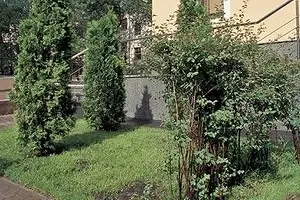
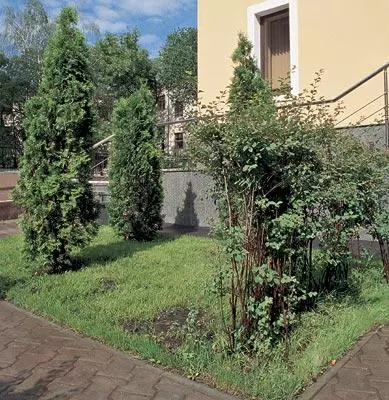
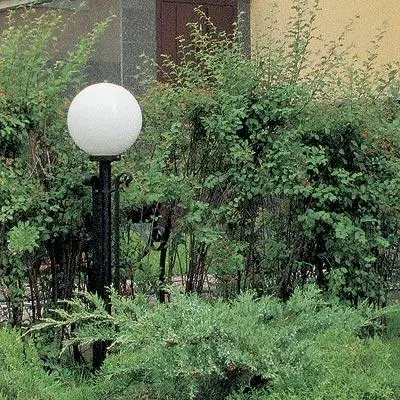
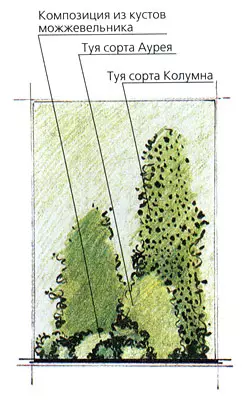
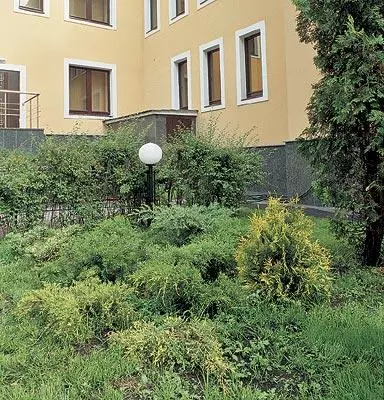
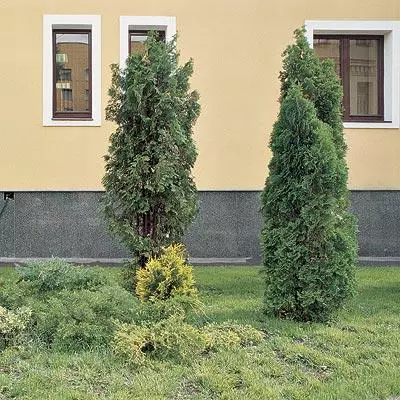
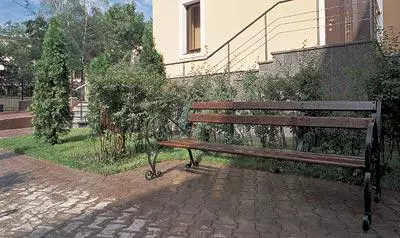
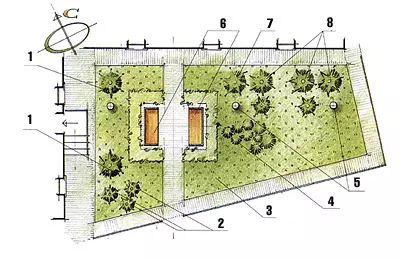
1. Thuja varieties Holmstrup
2. Thuja varieties Smaragd
3. Lawn
4. Composition of juniper bushes
5. Lanterns
6. Bembets
7. Juniper
8. Tui varieties of columns
The desire to have a beautiful and equipped plot of land near the house there are many. However, there is enough forces and time to care. Compromise is a simple landscape composition of coniferous plants.
What landscape would like to see any citizen from the window of his house? Of course, the causing peace after all experiences, stress and negative emotions of a turmoil day. It will be the opportunity to quickly ride an hour-other clean and fresh forest air. Finally, the landscape composition must necessarily be unique and not similar to others. Well, probably, many would have wanted to care for plants occupied at least time. Is it done all this? It turns out yes, if you turn to the professional - landscape designer.
Designing the landscape with the limitations of the centering land area, it is better to give preference to coniferous plants. Their attractive view, beautiful shape and moderate crown sizes in combination with the aroma of needles reveal the widest opportunities to create expressive landscape compositions not only on large areas, but also on small ones. In addition, such a flora of the latter "falls asleep" with the fallout of snow and the first "wakes up" under the ringing spring droplets. However, forest coniferous plants in the middle lane of Russia are a bit: spruce, pinea and juniper, and natural copies of rather tall, so with them a few years after landing, problems may arise. So, my neighbor put a small pine next to the house. After eight years he could admire the window only with its barrel, and not a crown, because she was already at the roof level.
Unique properties of conifers
Coniferous trees and shrubs with their needle or scaly leaves are not only long-livers, but also almost all of them evergreen plants. The live needles of any of them distinguishes special substances into the atmosphere - volatile phytoncides, filling air with specific spicy aroma and favorably affecting microflora. They suspend the reproduction of bacteria, viruses, microbes, infusories, microscopic fungi and some insects, sometimes just killing them. The most active "Sanitary" - Juniper. Usually the needles are long-term, keeps on the branches of 4-6 years (sometimes up to 10 and even 12 years old) and falls out gradually. Nature provided it with its ability to actively maintain photosynthesis in the conditions of either an intra-projectal climate of moderate latitudes, or subtropical climate. The needles of a row of plants, such as spin, are covered with a wax chain, helping them to survive in the urban atmosphere. In addition, the fallen needles overtakes slowly and serves as a good "blanket" for roots and raw materials for the formation of the upper fertile layer. Landscape designers carefully select the grades of coniferous plants not only on compatibility with the environment, the shape of the crown, the color of the needles, but also at the maximum height. And in small areas, low-spirited coniferous plants look much more attractive, their height in adulthood barely reaches 3-4 m.These plants do not discard long shadows, naturally "fit" into the cultural landscape, and all the listed positive qualities of conifers are not inherent to them to a lesser extent than tall "relatives". Their common feature is the dependence of growth and appearance from the purity of the air (first of all on the degree of gas and smoke), so they grow better away from cities and roads.In the middle strip of Russia in a good ecolo-gym and, subject to agrotechnical rules, coniferous trees can grow: pine, spruce, fir, larch (and it should be noted that it resets the needles for the winter), cedar, as well as coniferous shrubs: juniper, thuja , Tiss, Tsugov, cypressovik (and not cypress, not holding out cold weather).
To illustrate the possibilities of creating a man-made "oasis" of nature, we give the landscape of the urban area area around one weaving, on which a combination of ten copies of the Thuja of four varieties (Smaragd, Column, Aurea and Holmstrp) and nine bushes of five types of juniper (horizontal, Cossack, Chinese, ordinary and mountain). The frost-resistant plants are chosen to the soil and sufficiently adapted to the urban atmosphere. Regarding the wind roses, the site is located so that the wall of the building, heating, served as a source of reflected heat and simultaneously protected from cold northern winds.
According to the Dendroplane, the four of the highest column grades must completely close the simpleness between the windows, while the first pair of trees serves as the background for the longer thuja of the Holmstrup grade, and the second is for the Tui Aurea variety and at the same time for the composition of juniper bushes. A group of three Tui varieties Smaragd is located in the left corner of the site, and the two other thui grade Holmstrup - in front of the entrance to the house as the sentries. Undoubtedly, all the teu and bushes of juniper will grow up with time, but to see them in the "full height", you don't have to do the head, standing on the track.
Several general tips for agrotechnology of coniferous plants
- Treat between plants usually make from 0.8 to 1.5 m with a landing depth of at least 0.8 m. The root neck must be at the ground level. Soil is a ferry land with the addition of sand or clay. Drainage on heavy soil is required. For it, a layer of 20 cm thick is suitable, consisting of gravel and broken bricks.- In the first two seasons after planting, mineral fertilizers contribute in the amount of 30-40 g / cm2. The formation of thick-littered from the needles contributes to the formation of a fertile layer and the preservation of moisture. In the hot summer, lonely growing plants are recommended to water 3-5 times per season at the rate of 10-20 liters per each of them. It is desirable to sprinkle 2 times a month. It must be watered 2-3 times more often.
- Trims too compacted soil should periodically produce loosening at a depth of 10-15 cm. You can mulch with a chip layer 5-10 cm.
The shoot of shoots slow down, and the crown makes more thickly by trimming in the spring of one-year increases by about 1/3 of their length.
-Wasy height below 0.8 m usually suffer from winter burns, especially in the first five years of life. In October, they need to protect the huskien or kraft paper, which in early April is removed. Frost-resistant adult plants with a height of more than 1 m most often for the winter are not covered. All of the above and other types of work can be performed either by itself or for a certain fee to charge the company. It will also be responsible for their quality and timely execution.
Harmonious element of the landscape - track. It is paving the paving slabs, which, although it gives elegance, but does not look "solemn". In addition, paving slabs are cheaper than marble or natural stone. Two wooden benches are highlighted by low bushes of Van Gutta Spiray. Spirea frost resistant and lives up to 40 years. In the spring, small white flowers appear together on it. Shrub blooms for three weeks since the end of May. It is beautiful in the fall, covered with a reddish-purple foliage that rests until the end of October. Three low lamp are arranged in such a way that in the dark, to gently emphasize the harness of the thuy and at the same time do not lead to the formation of long shadows.On the rest of the area there is a lawn. It creates a medium for coniferous plants close to the forest, and also serves as a comfortable background, emphasizing their unique beauty. The lawn begins in a meter from the walls of the house, that is practically next to the celestial, which is dictated by saving area and convenient for its service, for example, for connecting the hose when watering. Sleeping Tui pyramidal shapes having compact crowns (and not scattered crowns, highly located characteristic of trees of a real coniferous forest), and neatly sprinkled on the lawn branches of juniper bushes do not grind space, which is very valuable at such a small volume. The absence of naked tree trunks reduces the variety of color palette of the landscape, limiting it in summer only with flowers from light yellow to dark green with the addition of shades of red. It helps her eyes get used to the constancy of the landscape, creates an atmosphere of calm and makes sense of self-confidence.
If the area of the plot is small, then you can put two benches opposite each other, and between them - a table for Sunday breakfast in nature. In this case, the track is better to expand a little.
You can fantasize and place several small boulders on the lawn and even "cross" the last murmur stream that the cultural landscape will be closer to natural, but, of course, will increase costs and add concerns. However, it is most likely not necessary to preserve the imitation of the natural landscape. In any case, the correct selection of coniferous plants, as well as simple care for lawn and spirires, will not require special hassle. Air purity, resinous fragrance and caressing the shades of green will deliver no less pleasure from the corner of nature than a walk in the real coniferous forest.
Landscaping, improvement and landscape design
In all articles on landscape design, three loved ones are usually used in the meaning of the term: landscaping, improvement and landscape design. What is their difference? Under the term "gardening" implies just planting green plants that increase the oxygen content in the air, reduce the effects of wind, street noise and the concentration of smoke, delay dust and aerosols. It can be separately growing trees and shrubs, their groups, flower beds, flower beds, alleys, alive hedges, stredized walls, bosets, etc.Improvement is aimed at creating the most convenient conditions for human habitat and includes both engineering training and landscaping.
The phrase "landscape design" implies the art of uniting nature with architectural works. This term came "due to a bulge." In 1858, F. Olmsted, winning the competition for the best project of the Central Park of New York, called himself a "landscaped architect". On its own land plots, one of the main directions of landscape design, called gardening art, are sold, - create a decorative garden.
